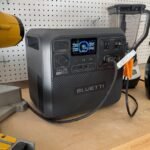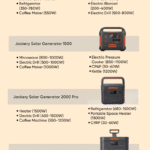Disclosure: This post contains affiliate links and I will be compensated if you make a purchase after clicking through my links. Learn More
Generator exhaust temperatures can reach between 600 to 1,200 degrees Fahrenheit. This high heat depends on the generator’s load and type.
Generators convert fuel into electrical energy, and this process generates significant heat. The exhaust system helps dissipate this heat, but the temperatures can get extremely high. Diesel generators often run hotter than gas-powered ones. Proper ventilation is crucial to ensure safety and efficiency.
High exhaust temperatures can pose fire hazards if not managed correctly. Regular maintenance and monitoring of the exhaust system can prevent overheating issues. Understanding these temperatures is essential for safe generator operation. Always follow manufacturer guidelines and safety measures to manage exhaust heat effectively.
Generator Exhaust Temperatures
Generators are essential machines that convert mechanical energy into electrical power. During this process, they produce exhaust gases. Understanding the generator exhaust temperatures is crucial for safety and efficiency. Hot exhaust can pose risks if not managed properly. This section delves into the typical temperature ranges and factors affecting these temperatures.
Typical Temperature Ranges
The temperature of a generator’s exhaust can vary. Generally, it ranges between 600°F (316°C) and 1,200°F (649°C). These temperatures depend on the generator type and load.
| Generator Type | Exhaust Temperature Range |
|---|---|
| Small Portable Generators | 600°F – 800°F (316°C – 427°C) |
| Industrial Generators | 900°F – 1,200°F (482°C – 649°C) |
Factors Affecting Temperature
Several factors influence the exhaust temperature of a generator. These include:
- Load: Higher load increases exhaust temperature.
- Fuel Type: Diesel, gasoline, and natural gas affect temperatures differently.
- Ambient Temperature: Hotter environments raise exhaust temperatures.
- Engine Condition: Well-maintained engines run cooler.
- Cooling Systems: Efficient cooling systems lower exhaust temperatures.
Understanding these factors helps in maintaining the generator. Regular monitoring ensures safe and efficient operations.

Health Risks
Generators produce exhaust that can get very hot. This presents serious health risks. Knowing these risks can help you stay safe.
Carbon Monoxide Poisoning
Generator exhaust contains carbon monoxide (CO). CO is a colorless and odorless gas. It is very dangerous. Breathing in CO can cause poisoning. Symptoms include headaches, dizziness, and nausea. In severe cases, it can cause death.
Always use generators in well-ventilated areas. Never run a generator indoors. Keep it away from windows and doors. Install CO detectors in your home. This can alert you to dangerous levels of CO.
Burn And Fire Hazards
Generator exhausts can reach temperatures of 600°F or more. This is hot enough to cause burns. Avoid touching the exhaust pipe. Keep children and pets away.
Hot exhaust can also ignite flammable materials. Do not place your generator near grass, leaves, or other debris. Make sure there is a clear area around the generator.
Use a fireproof mat under your generator. This can help prevent ground fires. Always have a fire extinguisher nearby.
| Health Risk | Safety Tip |
|---|---|
| Carbon Monoxide Poisoning | Use in well-ventilated areas, install CO detectors |
| Burn Hazards | Avoid touching, keep children and pets away |
| Fire Hazards | Keep area clear, use a fireproof mat |
Preventative Measures
Understanding how hot a generator exhaust gets is crucial. It can help prevent potential hazards. Here, we focus on key preventative measures to ensure safety and efficiency.
Proper Ventilation
Generators need proper ventilation to avoid overheating. Always place your generator in an open space. Ensure there is enough airflow around the unit. This helps to dissipate the heat generated during operation.
Here are some tips for ensuring proper ventilation:
- Place the generator at least 3 feet from walls.
- Do not enclose the generator in a small space.
- Use fans to improve airflow if needed.
Regular Maintenance
Regular maintenance of your generator is essential. This helps to keep the exhaust temperature under control. Follow a maintenance schedule to ensure your generator runs efficiently.
Consider the following maintenance tasks:
- Check and clean the air filter every 50 hours of use.
- Inspect the spark plug for wear and replace it if necessary.
- Change the engine oil after every 100 hours of operation.
Keeping a maintenance log can be very helpful. This ensures that no maintenance task is missed.
Read Here: How to clean generator air filter
Temperature Monitoring
Monitoring the exhaust temperature is vital. It helps in early detection of any issues. Use a temperature gauge to keep track of the exhaust heat. Ensure the temperature stays within safe limits.
Here are some tools you can use:
| Tool | Purpose |
|---|---|
| Infrared Thermometer | Measures surface temperature from a distance. |
| Temperature Stickers | Changes color when a certain temperature is reached. |
| Digital Temperature Gauge | Provides real-time temperature readings. |
Safety Equipment
Understanding how hot a generator exhaust gets is crucial. The exhaust can get very hot, reaching temperatures that can cause burns or fires. Safety equipment is essential to prevent accidents.
Heat Shields
Heat shields protect nearby objects from the hot exhaust. They help in reducing the risk of fire. Heat shields are usually made of metal or other heat-resistant materials.
Here is a table showing common materials used for heat shields:
| Material | Heat Resistance |
|---|---|
| Aluminum | Up to 1,221°F |
| Stainless Steel | Up to 2,700°F |
| Ceramic | Over 3,000°F |
Using a heat shield can make your generator safer. It is a simple and effective solution.
Carbon Monoxide Detectors
Carbon monoxide detectors are vital for safety. Generators produce carbon monoxide gas, which is dangerous. This gas is colorless and odorless, making it hard to detect.
Install carbon monoxide detectors in the areas where the generator is used. Here are some tips for using carbon monoxide detectors:
- Place detectors at least 15 feet away from the generator.
- Check batteries regularly.
- Test the detector monthly.
Carbon monoxide detectors can save lives. They alert you to dangerous gas levels quickly.
Regulatory Standards
Understanding the regulatory standards for generator exhaust temperatures is vital. These standards ensure safety and proper operation. Let’s dive into the specific guidelines and recommendations.
Osha Guidelines
The Occupational Safety and Health Administration (OSHA) sets safety rules. These rules help prevent workplace hazards.
- Exhaust temperatures must be controlled.
- Proper ventilation is required.
- Regular maintenance checks are essential.
OSHA guidelines help keep workers safe from high temperatures. They also ensure generators work efficiently.
Manufacturer Recommendations
Each generator manufacturer provides specific recommendations. These recommendations ensure the generator runs safely.
- Check the user manual for exhaust temperature limits.
- Follow maintenance schedules strictly.
- Use recommended parts and accessories.
Manufacturer guidelines are tailored to each model. They help maintain optimal performance and safety.
Summary
Adhering to OSHA guidelines and manufacturer recommendations is crucial. It ensures your generator operates safely and efficiently. Always consult the user manual and follow regulatory standards.

Emergency Procedures
Generators are useful but can be dangerous. Their exhaust gets very hot. Knowing emergency procedures can help. Let’s cover two critical areas: First Aid for Burns and Responding to Carbon Monoxide Exposure.
First Aid For Burns
If someone gets burned by a generator exhaust, quick action is crucial. Here are the steps to follow:
- Cool the Burn: Run cool water over the burn for 10-15 minutes.
- Remove Tight Items: Gently take off rings or tight clothing.
- Cover the Burn: Use a clean, non-stick bandage or cloth.
- Avoid Ice: Don’t use ice; it can damage skin more.
- Seek Medical Help: Contact a doctor for severe burns.
Responding To Carbon Monoxide Exposure
Carbon monoxide is a silent threat from generators. It can be deadly. Follow these steps if exposure is suspected:
- Move to Fresh Air: Get the person outside immediately.
- Call Emergency Services: Dial your local emergency number.
- Check for Symptoms: Look for headache, dizziness, or nausea.
- Administer Oxygen: If available, give 100% oxygen.
- Monitor Breathing: Ensure the person can breathe easily.
Generators are helpful but can be dangerous. Always take precautions and know emergency procedures.
Frequently Asked Questions
How Hot Can Generator Exhaust Get?
Generator exhaust temperatures can reach up to 1,200°F (650°C). This heat is due to fuel combustion.
Why Is Generator Exhaust So Hot?
Combustion of fuel in the engine produces high temperatures. The exhaust expels this heat to prevent engine overheating.
Can Generator Exhaust Cause Burns?
Yes, direct contact with generator exhaust can cause severe burns. Always exercise caution near exhaust outlets.
How To Safely Manage Generator Exhaust Heat?
Ensure proper ventilation and use heat-resistant barriers. Regularly inspect exhaust systems for damage or leaks.
Final Words
Understanding generator exhaust temperatures is crucial for safety. High temperatures can lead to serious hazards. Always ensure proper maintenance and ventilation. Knowing these details helps prevent accidents and prolongs your generator’s life. Stay informed to keep your equipment running efficiently and safely.








